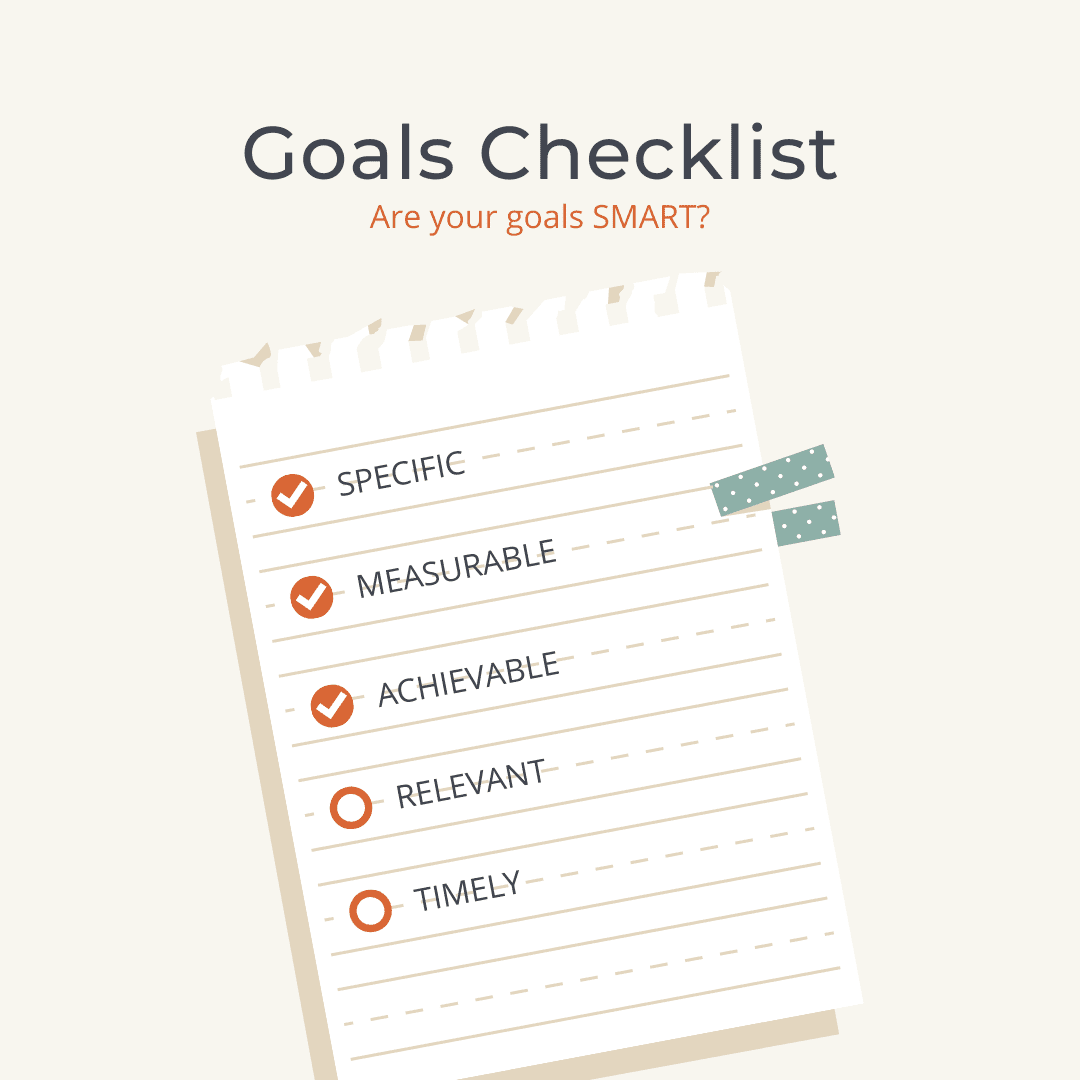How to Measure Your Personal Growth Goals
How to Measure Your Personal Growth Goals
What is it that would make you feel like you’ve achieved success in life? Would it be financial independence, a happy family, spiritual enlightenment, or a lifetime of service to others?
No matter what would make you happiest, the journey is just as important as the destination. And the journey is best accomplished by setting achievable goals along the way.
In order to get where you want to be, you should actively check in on your personal growth goals to ensure you’re actually making progress and staying on track, and measuring your success.
Knowing how to measure your personal growth can not only help prevent you from feeling discouraged about not achieving your goals immediately but also help you recognize and reward your progress in order to motivate yourself.
You are fully capable of creating the life you crave to live. And a key step in that process is measuring your progress toward your personal growth goals.
Why You Need to Set Personal Growth Goals
Setting goals helps you determine what you want in life. If you know where you want to be headed, you’re in control of your life more than letting it control you.
Setting and measuring goals is essential for your personal progress. It not only gives you focus, but it also motivates you and helps you defeat procrastination.
Goals come in all forms, but the best way to make a change in your life or the world around you is to have SMART goals. Remember, SMART Goals are:
Remember, SMART Goals are:
- Specific: Clear and concise instead of generalized or ambiguous
- Measurable: Able to be tracked so you can determine if you’re making progress
- Achievable: Challenging yet able to be accomplished so you don’t get discouraged
- Relevant: Aligned with your overall plans and other goals in life
- Timely: Attached to a finish time that’s realistic yet challenging
You’ll also discover that when you set personal growth goals, the compounding effect takes over. Hitting one goal opens the door to the next and the next and so on.
Therefore, your life is about progress, which inevitably brings you satisfaction and happiness.
5 Steps to Measure Your Personal Growth
Once you’ve clearly set your personal goals, you’ll need to track and measure your progress. The following five steps have helped me measure my personal growth and will give you the best possible chance of achieving everything you’re striving for.
Step 1: Set a Timeline for Yourself
To ensure your SMART goals are timely, set an end date for when you want to cross the finish line and achieve your goal.
Some of your goals may have built-in timelines. You might want to learn 50 key phrases in Spanish before going on your vacation to South America. Or you may want to save a certain amount of money for your child’s college education by the time they graduate from high school.
The proper timeline for other goals will be entirely up to you. For instance, you might want to write your first book before the end of the year or earn a seven-figure income by your 40th birthday.
The best timelines for your personal growth goals have a date that’s ambitious, but achievable. You’ll stay motivated if you challenge yourself, but don’t be too ambitious or you’ll run the risk of not achieving your goal and feeling defeated.
Start out by estimating how long it will take you to achieve your goal if everything goes 100% as planned. Then, write down a specific end date.
Next, ask yourself if you’ll likely need extra time or not, considering roadblocks that may come up. Or, do you want to push yourself even faster than a comfortable pace?
Once you settle on an end date, you’ll be able to create a timeline for what you will need to do each day, week, month, or year in order to achieve your goal on time.
Step 2: Reach for Milestones Along the Way
The timeline you’ve created will help you identify the milestones you’ll need to hit in order to achieve your goal.
If your goal is to read 24 self-improvement books this year, your milestones could include finishing a book every two weeks. It may also help you to figure out how many pages or chapters you should read each day.
Checking your milestones off will help motivate you to continue progressing forward. Milestones can also help you see if your timeline is too ambitious and needs to be altered to be more realistic yet still challenging.
These milestones will also help you look back and reflect on the ups and downs of your journey as you actively practice how to measure your personal growth.
Step 3: Track Your Progress
The next step in knowing how to measure progress on your goals is determining how to track them.
Many tools are available to you, so choose the one that you’re most comfortable with. Some people like to organize and track their goals in programs like Microsoft Excel and Google Sheets, for example.
Others prefer to utilize a project management tool, such as Asana, that is made specifically for tracking goals, setting up to-do lists, and monitoring progress.
You may also consider using a goal-setting app, like Goals Wizard, which has a companion website for tracking on your computer as well as your phone.
If any of those options do not seem right for you, though, a simple method of tracking your progress with pen and paper or a journal works perfectly. Whatever method you choose, the important part is that you have your goals in writing and are able to conveniently track them on a regular basis. People who write down their goals and progress are internally motivated to continue forward.
Whatever method you choose, the important part is that you have your goals in writing and are able to conveniently track them on a regular basis. People who write down their goals and progress are internally motivated to continue forward.
A key aspect of tracking your progress is writing your goals in the present tense. When you do this, your subconscious mind registers it as a command to give you motivation towards your goal.
For example, “I weigh 150 pounds on Valentine’s Day,” helps you visualize what you will look and feel like on that day, inspiring you with ideas on how to reach your goal and motivating you to make necessary changes.
It’s also important to track your emotions, thought processes, actions, and habits as well as your milestones. This can give you insight into the progress you’re making and what you may need to focus on to overcome obstacles. If progress is stagnant or moving backward, for example, it may be time to change something to kick start new growth.
Remember that learning how to manage your time wisely will catapult you toward success in reaching your goals. Learn time management tips for productivity to avoid distractions, prioritize your most important tasks each day and overcome procrastination.
Step 4: Set Specific Times to Measure Your Progress
The next key aspect of personal development measures is to check in on your progress regularly.
Be careful not to fall into the trap of setting amazing goals but then forgetting about them after an initial burst of motivation — like many New Year’s goals that fall by the wayside despite good intentions.
Instead, set a specific time to check in on your progress, and then make sure you follow up. Stay consistent with how you track your progress, whether it is daily, weekly, or otherwise. Think of it as an important business meeting, and don’t miss it ever!
Reaching your goals takes consistent effort. Be sure to hone your time management and organizational skills to help you stay focused and increase your productivity so you will reach your goals.
Step 5: Be Your Biggest Motivator
The final key to knowing how to measure your personal growth is to cheer yourself on. Learn positive affirmations that will help you stay motivated and encouraged, and remind yourself of them daily.
With any venture that requires change, difficulties will inevitably arise — even setbacks. But this is all part of the natural process.
Never beat yourself up if you fall behind or miss a benchmark. Instead, see it as a learning experience that can help propel you to further progress.
The key to measuring your growth is to be aware of it, accept it and make changes to fix it. Therefore, it’s necessary to be honest with yourself instead of making excuses or ignoring obstacles.
Be adaptable and flexible with how things change throughout your personal growth process while holding yourself accountable and moving forward.
Tips to Hold Yourself Accountable
When you have a system set in place to help you stay accountable to your goals, you’re more likely to achieve them. This often means involving someone else in your journey toward personal progress and celebrating your achievements. Consider our top three tips for holding yourself accountable in your goal setting:
- Find accountability partners or join a mastermind group to share your goal with so that they can help you stay on track by motivating you to reach your milestones and celebrating with you as you accomplish them.
- Set rewards for achieving milestones, such as a day off, a special outing with your family, or a new book to read—whatever will help motivate you personally to achieve the steps toward your goal.
- Share your progress on social media or with your friends and family to help you stay accountable by publicly recording or sharing with those important to you how you’re progressing toward your milestones.
Set Your Next Personal Growth Goal
Creating your best life starts with identifying what you most want out of life, setting SMART goals to get you there, and then applying the principles of how to measure your personal growth.
Once you’ve achieved your goal, there is always a new one waiting to discover. As you measure your progress on any goal, you’ll be able to see where you got stuck and where you excelled. Then you can use that to learn and succeed as you start thinking about your next goal.



![[LIVE] Engage2Earn: McEwen boost for Rob Mitchell](https://cdn.bulbapp.io/frontend/images/c798d46f-d3b8-4a66-bf48-7e1ef50b4338/1)



















![[ℕ𝕖𝕧𝕖𝕣] 𝕊𝕖𝕝𝕝 𝕐𝕠𝕦𝕣 𝔹𝕚𝕥𝕔𝕠𝕚𝕟 - And Now What.... Pray To The God Of Hopium?](https://cdn.bulbapp.io/frontend/images/79e7827b-c644-4853-b048-a9601a8a8da7/1)



















